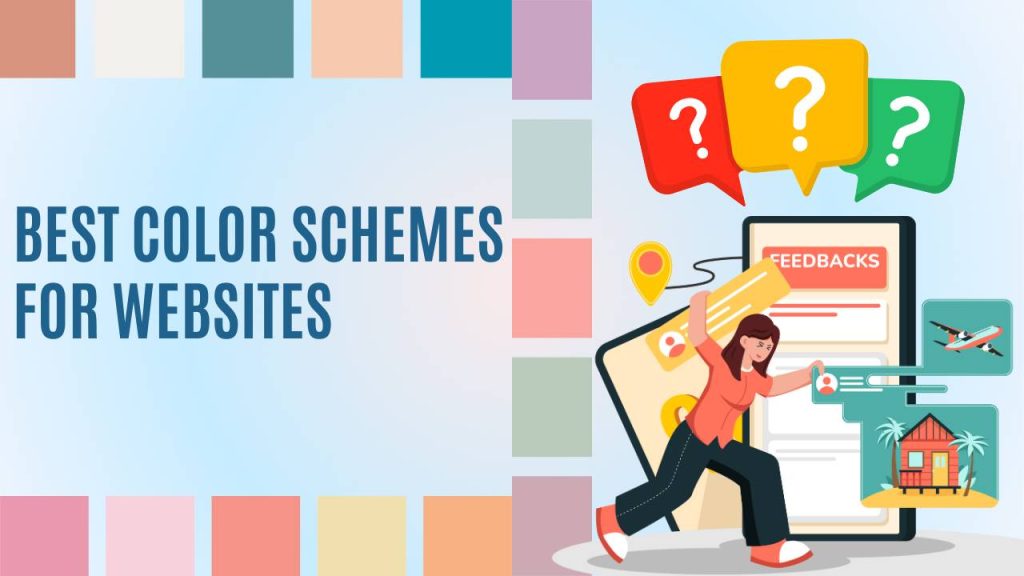Strong color choices set the tone for your entire website. The best color schemes for websites grab attention, build brand identity, and enhance user experience. With the right palette, you create visual harmony that keeps users engaged and leaves a lasting impression. In this, I share 20 powerful and stylish color schemes that elevate web design and truly wow users.
How to Choose the Best Color Schemes for Websites in 2025
Before diving into specific color schemes, it’s crucial to understand the foundational elements behind choosing the best color schemes for websites—especially in 2025, where design trends continue to evolve with a focus on personalization, inclusivity, and user-centric experiences. Right color palette not only influences the visual appeal but also impacts user behavior, brand recognition, and overall engagement. Here are the key factors you should consider when selecting a website color scheme in 2025:
Brand Identity
Color is one of the strongest visual tools to convey your brand’s identity. Each shade can evoke specific emotions and communicate your brand message instantly. For instance, a wellness or skincare brand may benefit from soft pastels like mint green, lavender, or blush pink, which convey calmness and purity.
On the other hand, a fintech or tech-focused brand might lean toward cool-toned palettes like deep blues, slate grays, or sleek blacks that convey professionalism, innovation, and trust. Your primary colors should resonate with your brand’s voice—whether it’s playful, elegant, energetic, or minimal.
Target Audience
Understanding who you’re designing for is just as important as knowing what you’re designing. Younger audiences, particularly Gen Z and Millennials, are drawn to vibrant, high-contrast, and expressive colors—think electric blues, bold reds, and neon gradients.
They appreciate modern aesthetics and creative risks. Meanwhile, older audiences often find comfort in more subdued palettes—warm neutrals, navy blues, and classic shades that exude stability and reliability. Cultural context also plays a role, so research color preferences based on your audience’s region or background to build stronger emotional connections.
Accessibility
In 2025, inclusive web design is no longer optional—it’s expected. Accessibility should be a priority when selecting your color scheme. That means choosing combinations with sufficient contrast between text and background, avoiding color pairings that are difficult for color-blind users to distinguish, and ensuring that information isn’t conveyed by color alone.
Tools like the WebAIM Contrast Checker or Adobe’s Accessibility Tools can help ensure compliance with accessibility standards like WCAG 2.1. Making your site inclusive not only improves usability but also expands your reach to a wider audience.
Trends
Design trends are an ever-evolving part of the digital landscape. In 2025, we’re seeing a shift toward visually rich, emotionally resonant palettes. Color gradients—especially those blending cool and warm tones—are dominating hero sections and backgrounds. Earth tones, including terracotta, sage, and sand, are bringing a sense of grounded calmness and sustainability into modern design.
Meanwhile, neon contrasts and futuristic combinations are making a splash in tech and creative portfolios, offering a bold way to stand out. Being aware of current trends allows you to design a website that feels modern while still aligning with your brand’s identity.
By carefully balancing these factors—brand message, user preferences, accessibility, and evolving trends—you can confidently choose the best color schemes for websites that not only look great but perform well across all user experiences.
Best Color Schemes for Websites That Boost User Engagement
Strategic use of color is a powerful tool in web design. When chosen carefully, colors can influence emotion, direct user behavior, and significantly increase engagement metrics like time on site, click-through rate, and overall conversion. Below, I’ve broken down some of the best color schemes for websites that not only enhance visual appeal but also strengthen user connection and interaction:
1. Monochromatic Blues – Clean, Trustworthy, and Calming
Using a range of blue tones—from light sky blue to navy—creates a professional and calming environment. This scheme works exceptionally well for corporate, finance, and SaaS websites because blue evokes feelings of trust, intelligence, and stability. It helps users feel secure while navigating complex data or services. This palette is also easy on the eyes, making it suitable for content-heavy platforms or dashboards. The subtle shifts in hue maintain interest without overwhelming the user, encouraging longer browsing sessions.
2. Black, White & Red Accents – Bold, Minimal, and Memorable
This high-contrast palette commands attention with its timeless elegance. The use of deep black and crisp white provides a neutral canvas that allows red accents to truly shine—drawing attention to key elements like call-to-action buttons, featured products, or important headlines. This scheme is ideal for portfolios, fashion brands, and luxury products, where strong first impressions matter. It exudes sophistication while guiding users through a clear and focused visual journey.
3. Sunset Gradient (Orange to Purple) – Warm, Emotional, and Dynamic
This gradient taps into natural, familiar visuals—like a summer sunset—to evoke warmth, energy, and emotional connection. The smooth transition from orange (representing enthusiasm and creativity) to purple (signifying mystery and imagination) creates a storytelling atmosphere that’s ideal for blogs, creative platforms, or travel websites. The depth of the gradient adds dimension and movement, keeping users visually engaged while navigating long-form content or immersive experiences.
4. Mint Green and Charcoal – Fresh, Trendy, and Balanced
Pairing a soft, refreshing mint green with a grounded charcoal gray strikes a modern and sophisticated balance. This color scheme is particularly effective for eCommerce sites that want to highlight product freshness, sustainability, or innovation. Mint evokes cleanliness and calm, while charcoal brings in a sense of structure and authority. Together, they create a pleasant shopping experience that builds trust and encourages conversions without overwhelming the user.
5. Sky Blue, Cream, and Soft Pink – Gentle, Inviting, and Aesthetic
This palette is a favorite among lifestyle bloggers, wellness brands, and personal portfolio sites. The combination of sky blue and soft pink provides a light, airy feel that is visually soothing and highly appealing. Cream acts as a neutral base, allowing the other two colors to stand out without clashing. This scheme works exceptionally well when storytelling or emotional engagement is the goal. It appeals particularly to audiences who value comfort, creativity, and authenticity, making them feel welcome and more likely to explore further.
Best Color Schemes for Websites by Industry (eCommerce, SaaS, Blogs)
Choosing the best color schemes for websites often depends on your industry and the emotions or behaviors you want to evoke. Each sector serves a different audience and delivers a unique type of experience—so the colors you use should support those goals. Here’s a detailed breakdown of effective color palettes by industry and why they work:
1. eCommerce Websites
Color Scheme: White background with black or dark gray text, accented by bright call-to-action (CTA) buttons in orange, green, or red.
Why It Works:
eCommerce thrives on clarity and immediacy. A white background provides a neutral canvas that keeps the focus on the products. Black or dark text ensures maximum readability, which is critical when presenting product descriptions, specs, or pricing. Bright CTA buttons—like orange for urgency, green for reassurance, or red for excitement—stand out instantly and guide users toward purchasing decisions.
These colors also help create a sense of movement and interactivity, boosting conversion rates while maintaining a clean and organized visual structure.
2. SaaS & Tech Platforms
Color Scheme: A cool palette consisting of various shades of blue, complemented by white backgrounds and touches of gray or silver.
Why It Works:
Blue has long been associated with trust, reliability, and intelligence—all traits essential for tech brands and software platforms. When combined with white, the result is a clean, uncluttered interface that emphasizes usability and performance. Gray or silver accents add a layer of sophistication and neutrality, allowing data-heavy interfaces to remain user-friendly and digestible.
This palette supports a professional tone, builds user confidence, and subtly reinforces the message that the platform is dependable and cutting-edge.
3. Health & Wellness Blogs
Color Scheme: Earthy tones like olive green, soft beige, pale browns, and calming sky blues.
Why It Works:
In the health and wellness space, it’s important to evoke a sense of peace, balance, and connection to nature. Earth tones are known to calm the nervous system and make users feel grounded. Olive green symbolizes growth and healing, while beige and soft browns convey warmth and simplicity.
Sky blue introduces a sense of openness and calm, often associated with mental clarity and relaxation. Together, these tones help create a space that feels personal, safe, and inviting—perfect for encouraging reflection, mindfulness, and lifestyle engagement.
4. Creative Portfolios
Color Scheme: A dramatic mix of black and white with bold neon or vibrant accent colors like electric blue, hot pink, or bright yellow.
Why It Works: Creative professionals—whether designers, photographers, or artists—need color schemes that highlight their originality while keeping the focus on their work. A minimalist base of black and white gives the portfolio a clean, gallery-like presentation.
The use of neon accents injects energy and modernity, drawing the eye to key elements like project titles, navigation buttons, or CTAs. This palette creates strong contrast and visual interest, helping creative content stand out and leaving a lasting impression on viewers and potential clients.
Modern and Minimalist Best Color Schemes for Websites
Minimalist design doesn’t mean dull or lifeless—it’s about removing visual noise and emphasizing clarity, intention, and function. In 2025, the best color schemes for websites that lean into minimalism are gaining popularity for their ability to create elegant, focused user experiences. These refined palettes work across industries and devices, making your website feel sleek, modern, and trustworthy.
1. White, Black, and Gray – Ultra-modern and Timeless for Tech Startups
This trio is the gold standard for minimalist web design. The crisp white background creates a sense of openness and space, allowing your content to breathe. Black text brings in strong contrast for easy readability, while shades of gray help segment content and add visual hierarchy without clutter.
This scheme is widely used by tech startups, software platforms, and innovation-focused brands looking to convey professionalism, precision, and cutting-edge thinking. It also supports seamless dark-mode transitions, which are increasingly favored in 2025.
2. Beige and Olive Green – Subtle, Earthy, and Ideal for Sustainable Brands
This earthy palette speaks directly to eco-conscious audiences and brands in the health, wellness, or sustainable product spaces. Beige serves as a warm, welcoming base that feels organic and grounded. Olive green adds a natural touch while still maintaining sophistication and maturity.
Together, these colors evoke calmness, environmental awareness, and authenticity—qualities that today’s mindful consumers appreciate. This scheme is perfect for showcasing sustainable fashion, organic skincare, or green lifestyle blogs.
3. Blush Pink and Cream – Soft, Elegant, and Widely Loved in Fashion & Beauty
Blush pink paired with a creamy off-white creates a delicate, luxurious aesthetic that feels fresh and feminine without being overly playful. It works beautifully for beauty brands, influencers, and fashion-forward sites that want to project elegance, subtle charm, and high-end appeal.
Cream provides a neutral, calming base while blush introduces a sense of personality and warmth. This palette is also highly adaptable to product photography, allowing visuals to pop without clashing with the design.
4. Deep Navy and Light Gold – Sophisticated, Luxurious, and Understated
Deep navy brings in richness and depth, anchoring the site visually, while light gold offers a refined, muted contrast that feels both premium and approachable. This pairing is a favorite among luxury brands, consultants, interior designers, and high-end service providers.
Unlike loud metallics, the gold used here is soft and matte—suggesting quality without the flashiness. Navy’s professional, confident tone combined with gold’s quiet glamour sends a message of reliability, elegance, and timeless style.
Dark Mode vs Light Mode: Best Color Schemes for Websites Compared
As digital design evolves, more users are expecting websites and apps to support both dark and light modes. With operating systems and browsers offering these modes as default settings, it’s no longer optional for designers to choose just one.
Today’s best websites are responsive not only in layout but also in how they cater to light and dark visual preferences. Let’s break down the strengths of each mode and explore ideal color schemes tailored for both.
Light Mode Advantages
1. Easier to Read in Daylight:
Light mode performs best under bright lighting conditions, especially natural daylight. The high contrast between dark text and a light background improves legibility for users browsing outdoors or in well-lit workspaces.
2. Feels Open and Clean:
A white or soft light-colored background creates a sense of openness and minimalism. It allows the content to breathe, giving a professional and organized impression that works well across industries—from eCommerce to educational platforms.
3. Preferred for Content-Heavy Sites:
When users are engaging with large volumes of text—such as on news platforms, blogs, or documentation-heavy SaaS tools—light mode enhances readability by offering clean, crisp contrast and reducing cognitive fatigue over long reading sessions.
Dark Mode Advantages
1. Reduces Eye Strain in Low-Light Environments:
Dark mode offers a more comfortable viewing experience in dim settings. By using darker backgrounds and softer text tones, it limits the intensity of emitted light and helps prevent digital eye fatigue, especially during nighttime browsing.
2. Feels Sleek and High-Tech:
Aesthetic of dark mode is often associated with innovation, modernity, and elegance. Tech startups, gaming platforms, and creative portfolios use dark mode to project a cutting-edge feel that resonates with design-forward users.
3. Helps Save Device Battery:
On OLED and AMOLED screens, dark mode significantly reduces power consumption because black pixels consume less energy. For mobile-first designs, this optimization improves the overall experience by helping prolong battery life on smartphones and tablets.
Top Dark Mode Color Scheme
Background: Charcoal Black
A true black background can feel too harsh or flat, so designers lean toward charcoal or graphite tones that offer depth without being overpowering. This tone reduces eye strain while maintaining sophistication.
Text: Soft White
Instead of pure white, which can feel stark against a dark background, soft white or light gray text provides a smoother, more pleasant reading experience. It maintains clarity while being easy on the eyes.
Accent: Electric Blue or Magenta
Bright, saturated colors like electric blue or magenta pop beautifully against a dark canvas. These accents can highlight key CTAs, links, or hover effects without compromising readability or visual harmony.
This dark color scheme works exceptionally well for dashboards, developer tools, modern portfolios, and entertainment platforms where engagement and aesthetics go hand-in-hand.
Top Light Mode Color Scheme
Background: White
A clean white background acts as a neutral base that keeps the interface feeling fresh, spacious, and organized. It’s the most versatile foundation, suitable for a wide range of content types and audiences.
Text: Dark Gray
Rather than stark black, dark gray text adds a softer, more refined touch while maintaining legibility. It reduces strain on the eyes during prolonged reading and offers a polished aesthetic for editorial and business websites.
Accent: Sky Blue or Orange
Sky blue delivers a sense of calm and reliability, perfect for CTAs and interactive elements. Orange, on the other hand, energizes the layout and draws immediate attention to buttons or notifications. Both work well as highlight colors without overwhelming the user interface.
This light color scheme is best suited for lifestyle blogs, professional services, eLearning platforms, and eCommerce stores aiming for accessibility, clarity, and broad appeal.
Psychology Behind the Best Color Schemes for Websites
Colors do more than make your website look attractive—they subconsciously guide how users feel, interact, and even make purchasing decisions. That’s why understanding the psychology behind colors is essential when choosing the best color schemes for websites. Trying to build trust, inspire action, or evoke emotion, the right color choices can dramatically enhance user engagement and conversion.
1. Red – Urgency, Excitement, and Boldness
Red is one of the most emotionally intense colors. It stimulates energy and increases heart rate, which can push users to take quick action. This makes red an ideal choice for clearance banners, limited-time offers, and CTAs that demand immediate attention. However, because red is so dominant, it works best when used sparingly—for example, as an accent on buttons or warnings—so it doesn’t overwhelm the overall design.
Best for: Flash sales, food industry websites, promotional campaigns, and fashion sites with bold brand identities.
2. Blue – Trust, Calmness, and Reliability
Blue is universally associated with stability and trust. It’s no surprise that many financial institutions, SaaS companies, and healthcare providers incorporate shades of blue into their websites. Lighter blues create a calming effect, perfect for meditation or mental wellness brands, while deeper navy tones project authority and competence. Blue is a great base color for businesses that want to communicate dependability and professionalism.
Best for: Tech startups, banks, insurance platforms, and medical websites.
3. Green – Health, Nature, and Growth
Green is often linked to health, renewal, and eco-friendliness. It has a soothing effect on the mind and body, making it a popular choice for wellness apps, environmental nonprofits, and health-conscious eCommerce stores. Lighter greens evoke a fresh, organic feel, while darker forest greens bring a sense of tradition and stability. It’s also associated with financial growth, which is why it works well on investment or fintech platforms.
Best for: Eco-brands, nutrition blogs, fitness apps, agriculture, and financial tools.
4. Yellow – Optimism, Energy, and Attention
Yellow is the most visible color to the human eye and instantly evokes a sense of happiness and warmth. It’s often used to grab attention quickly—think caution signs or sale tags. While yellow can create a cheerful and youthful vibe, too much of it can cause anxiety or fatigue, so it’s best used as a supporting color. Strategically placed yellow elements like icons, callouts, or highlights can boost engagement without overwhelming users.
Best for: Children’s websites, creative portfolios, startups, and lifestyle blogs looking to inject energy and positivity.
5. Purple – Luxury, Mystery, and Creativity
Purple has long been associated with royalty, luxury, and imagination. It’s a color that stimulates creativity and is often found on websites targeting a more artistic or premium audience. Lighter lavenders can evoke a soft, dreamy experience, ideal for beauty and wellness brands, while deeper purples communicate exclusivity and mystery. Purple works especially well in industries where storytelling, uniqueness, or artistic value is key.
Best for: Beauty products, high-end services, creative studios, and spiritual or wellness platforms.
6. Black – Sophistication, Power, and Elegance
Black is powerful, sleek, and timeless. It adds depth and a sense of exclusivity to a brand. Often used in luxury product websites, black backgrounds can make visuals pop, especially when showcasing premium goods like watches, cars, or designer fashion. When combined with white and gold accents, black amplifies the perception of value and sophistication. It’s also an excellent foundation for minimalist designs when used with ample whitespace.
Best for: Luxury fashion, high-end electronics, photography portfolios, and minimalist brands.
How to Track Keyword Ranking in Google Analytics Like a Pro
Remember, colors convey emotions, guide actions, and build brand loyalty. By implementing thoughtful and strategic color schemes, you’ll be setting your website up for maximum visual impact and engagement in 2025 and beyond.
FAQs
1. What are the best color schemes for websites in 2025?
In 2025, trending website color schemes include warm gradients, earthy tones, monochrome with accents, and minimalist pastel palettes. These schemes offer emotional connection, accessibility, and visual comfort.
2. How do I choose the best color scheme for my website?
Start with your brand identity, audience preferences, and emotional tone. Consider accessibility, contrast, and the message you want to send. Use tools like Adobe Color or Coolors to test palettes.
3. Which colors increase website engagement?
Bright CTA colors like orange, green, or electric blue can improve engagement. Calming backgrounds paired with vibrant accents guide user focus and improve interaction.
4. What are some timeless website color schemes?
Black and white with red accents, navy and gold, and blue-gray combos are classic schemes that work across multiple industries and still feel modern today.
5. Are dark mode color schemes better than light mode?
Dark mode reduces eye strain and feels modern, especially for tech-focused websites. Light mode is ideal for readability in daylight. The best websites offer both options.
6. What are the best color schemes for eCommerce sites?
Clean white backgrounds with black text and bright call-to-action colors like green or orange help highlight products and simplify decision-making.
7. Which colors are best for SaaS and tech websites?
Cool tones like navy, sky blue, white, and gray communicate trust, innovation, and clarity—ideal for software products and digital services.
8. What’s the best color scheme for blogs?
Lifestyle and wellness blogs benefit from soft tones like cream, peach, and mint. For tech or financial blogs, try blue, gray, and white combos for readability and trust.
9. Should I avoid certain color combinations?
Avoid low-contrast combos like yellow text on a white background or red on green. These hinder readability and can be problematic for color-blind users.
10. How important is accessibility in color schemes?
Extremely important. Use high contrast ratios and tools like the WebAIM Contrast Checker to ensure your website is readable for all users, including those with visual impairments.




